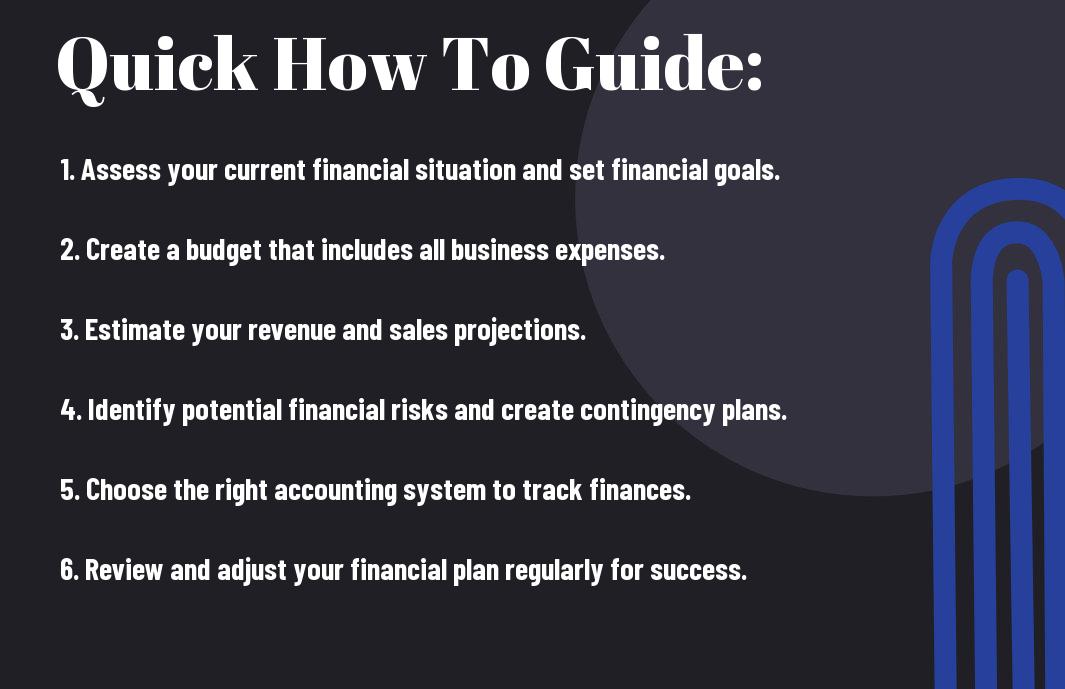How to Create a Solid Small Business Financial Plan
Are you struggling to establish a secure financial plan for your small business? The success of any small business relies heavily on its financial stability, and creating a solid financial plan is crucial to achieving that stability. In this blog post, you will learn how to develop a financial plan that will guide you towards financial success and security for your small business.
When it comes to creating a financial plan for your small business, it is important to determine your goals and objectives for the business, as well as to analyze your current financial situation thoroughly. This will allow you to identify any potential risks and challenges that may arise, and will help you develop a strategic plan to overcome them. In this blog post, you will learn the essential steps to creating a strong financial plan for your small business, ensuring the long-term success of your endeavors.
Key Takeaways:
- Understanding Your Cash Flow: It is essential for small businesses to closely monitor and manage their cash flow to ensure consistent liquidity and financial stability.
- Setting Realistic Financial Goals: Small businesses should establish achievable financial goals and create a solid plan to work towards them, ensuring they align with the overall business objectives.
- Regularly Reviewing and Revising the Financial Plan: It is important for small businesses to regularly review and revise their financial plan to adapt to changing market conditions and ensure its effectiveness in achieving long-term financial success.

Understanding the Basics
If you’re just starting out with small business financial planning, it’s essential to first understand the basics. Doing so will ensure you have a solid foundation to build upon as you move forward. To get started, you’ll want to familiarize yourself with the key elements and concepts that make up financial planning. For a comprehensive guide on this, check out How to Conduct Small Business Financial Planning Effectively.
Definitions of Key Financial Terms
When it comes to creating a financial plan for your small business, it’s crucial to have a clear understanding of key financial terms. These terms include revenue, expenses, profit, and cash flow. Revenue refers to the total income generated by your business before any expenses are deducted. Expenses are the costs incurred to run your business. Profit is your total revenue minus your total expenses. And cash flow refers to the amount of money coming in and going out of your business.
The Relationship Between Cash Flow, Profit, and Revenue
Understanding the relationship between cash flow, profit, and revenue is essential for effective small business financial planning. While revenue is important for the overall success of your business, cash flow is the lifeblood that keeps your business operations running smoothly. If your cash flow is negative, it could indicate trouble ahead, even if your business is profitable on paper. On the other hand, a positive cash flow ensures that you have enough money to cover your expenses and invest in the growth of your business. So, it’s crucial to manage your cash flow effectively to maintain a healthy and sustainable business.

Assessing Your Current Financial Position
Unlike large corporations, small businesses often have limited resources and cannot afford to make financial missteps. It’s important to thoroughly assess your current financial position to understand where your business stands and where it needs to go. This will help you create a solid financial plan to guide your business towards success.
How to Analyze Your Business’s Financial Statements
One of the first steps in assessing your financial position is to analyze your business’s financial statements. This includes reviewing your income statement, balance sheet, and cash flow statement. The income statement shows your business’s profitability over a certain period, while the balance sheet provides a snapshot of your business’s financial position at a specific point in time. The cash flow statement shows how cash is flowing in and out of your business. By carefully analyzing these statements, you can gain valuable insights into your business’s financial health and identify areas that require attention.
Tips for Effective Bookkeeping Practices
Effective bookkeeping practices are essential for maintaining accurate financial records and making informed business decisions. Make sure to keep detailed records of all your business transactions, including income and expenses. This will help you track your cash flow and monitor your business’s financial performance. Utilize accounting software to streamline your bookkeeping process and ensure accuracy. Additionally, reconcile your bank statements regularly to detect any discrepancies or errors. Keep your personal and business finances separate to maintain clarity and avoid confusion. By implementing these bookkeeping practices, you can maintain organized financial records and make well-informed decisions for your business. Knowing where your money is coming from and going to is crucial for laying a strong financial foundation for your small business.
Setting Financial Goals and Objectives
Not having clear financial goals and objectives for your small business can lead to financial instability and lack of direction. Setting financial goals and objectives is crucial for the success of your business, as it gives you a roadmap to follow and allows you to track your progress.
How to Define Short-term and Long-term Financial Goals
When defining short-term financial goals, you are looking at the immediate future, usually within the next 12 months. These goals could include increasing your monthly revenue, reducing expenses, or increasing your cash reserves. On the other hand, long-term financial goals are focused on where you want your business to be several years from now. This could involve expanding your operations, opening new locations, or achieving a certain level of profitability.
Factors to Consider When Setting Financial Targets
When setting financial targets for your small business, there are several factors you need to consider. Firstly, you need to take into account your current financial position. Assess your current revenue, expenses, and cash flow to determine where you stand. Next, consider the external factors that can impact your financial goals, such as market trends, customer behavior, and competitive landscape. Additionally, it’s important to set realistic and achievable targets. Setting unattainable goals can lead to frustration and demotivation. Finally, consider the timeframe within which you want to achieve your financial targets. Are they short-term, long-term, or a combination of both?
- Current financial position: Assess your revenue, expenses, and cash flow.
- External factors: Consider market trends, customer behavior, and competition.
- Realistic targets: Set achievable goals to avoid frustration.
- Timeframe: Determine whether your goals are short-term, long-term, or a combination.
Knowing these factors will help you in setting financial targets that are both challenging and realistic, ultimately leading to the growth and success of your small business.
Creating the Financial Plan
Now that you understand the importance of having a solid financial plan for your small business, it’s time to dive into the process of creating one. A well-thought-out financial plan will help you set clear goals, manage your resources efficiently, and stay on track for long-term success. Here’s how you can get started with creating a comprehensive financial plan for your small business.
How to Project Revenue and Expenses
When creating your financial plan, the first step is to project your revenue and expenses. This involves making realistic estimates of the income you expect to generate and the costs you anticipate incurring over a specific period. Start by analyzing past financial data to identify trends and patterns that can help you forecast future revenue and expenses. Factor in variables such as seasonal fluctuations, market trends, and potential business growth. It’s essential to be as accurate as possible in your projections to avoid any surprises down the line.
Tips for Effective Cash Flow Management
Effective cash flow management is vital for the financial health of your small business. To maintain a positive cash flow, you must monitor your cash inflows and outflows closely. Create a cash flow forecast to predict when money will be coming in and when it will be going out, allowing you to plan accordingly. Invoice promptly and encourage early payments from your customers to boost your cash flow. Additionally, consider negotiating favorable terms with suppliers to optimize your cash management. Regularly review and update your cash flow projections to identify any potential shortfalls or surpluses. This will help you make informed decisions and take proactive measures to address any cash flow challenges.
- Invoice promptly and follow up on late payments
- Negotiate favorable terms with suppliers
- Regularly review and update your cash flow projections
Recognizing the importance of maintaining a healthy cash flow will enable you to navigate through any financial ups and downs effectively.
Incorporating Contingency Plans for Financial Risks
It’s crucial to incorporate contingency plans for potential financial risks into your overall financial plan. Identify potential risks that could impact your business, such as economic downturns, unexpected expenses, or changes in market conditions. Develop strategies to mitigate these risks and establish a reserve fund to cushion your business in case of emergencies. By being prepared for unexpected challenges, you can safeguard your business’s financial stability and protect it from potential setbacks.
Funding Your Business
To ensure the success and sustainability of your small business, it is crucial to have a solid financial plan in place. One of the key elements of this plan is securing the necessary funding to get your business off the ground and keep it running smoothly. This chapter will delve into the various aspects of funding your business and provide you with essential guidance to make informed decisions.
How-to Guide for Securing Loans and Investments
When it comes to securing the capital needed to start or grow your small business, there are several options available to you. One of the most common methods is through loans and investments. To successfully secure these forms of funding, it is imperative that you have a well-thought-out business plan and financial projections in place. You will need to demonstrate to potential lenders or investors that your business is a sound investment with a high potential for success. Additionally, be prepared to provide collateral, a solid credit history, and a clear repayment plan to increase your chances of obtaining the funding you need.
Factors to Consider When Choosing Financing Options
When evaluating the different financing options available to you, there are several factors that you should take into consideration. Firstly, consider the interest rates and terms associated with each option. High interest rates can significantly impact your business’s cash flow and profitability. Secondly, assess the level of control you are willing to relinquish in exchange for funding. Some financing options may require you to give up a certain degree of control over your business operations. Thirdly, think about the impact that the repayment schedule will have on your business’s financial stability. Ensure that you choose a financing option with a repayment plan that aligns with your business’s cash flow and revenue projections. Finally, assess the potential risks involved with each financing option and consider how they may impact your business’s ability to grow and thrive.
- Interest rates and terms: High interest rates can significantly impact your business’s cash flow and profitability.
- Level of control: Consider the degree of control you are willing to relinquish in exchange for funding.
- Repayment schedule: Choose a financing option with a repayment plan that aligns with your business’s cash flow and revenue projections.
- Risk assessment: Assess and consider the potential risks involved with each financing option and how they may impact your business’s ability to grow and thrive.
Assume that the financing option you choose will have a significant impact on your business’s financial health and long-term prospects. Therefore, it is imperative to thoroughly evaluate and consider all available options to make the best choice for your business.
“`html
Managing Financial Growth
Despite the challenges and risks, managing financial growth is an essential aspect of running a small business. It requires careful planning, strategic decision-making, and responsible allocation of resources.
Tips for Scaling Your Business Finances Responsibly
When scaling your business, it’s important to manage your cash flow effectively. This means you need to closely monitor your expenses and revenues to ensure that you have enough working capital to support your growth. You should also consider seeking additional financing options to support your expansion, whether it’s through traditional bank loans, lines of credit, or investor funding. Furthermore, diversifying your revenue streams can help reduce your dependency on a single source of income and mitigate financial risks.
- Monitor your cash flow effectively
- Consider seeking additional financing options
- Diversify your revenue streams
Assume that you will encounter unexpected challenges and expenses as you scale your business, so it’s important to have a strong financial foundation to weather any storms that may come your way.
How to Reinvest Profits to Promote Sustainable Growth
When your small business starts generating profits, it’s tempting to pocket the money. However, reinvesting your profits back into the business is crucial for sustainable growth. You can invest in technology and automation to streamline your operations and improve efficiency. This may involve upgrading your software systems or implementing automation tools to reduce manual workloads. Additionally, consider expanding your product lines or entering new markets to capitalize on growth opportunities and increase your revenue streams.
“`
Monitoring and Revising Your Financial Plan
For your small business financial plan to be effective, it’s crucial that you regularly monitor and revise it as needed. Financial management is an ongoing process, and staying on top of your plan will help you make informed decisions and keep your business on track for success.
How to Use Financial Ratios and Metrics for Effective Analysis
Financial ratios and metrics are valuable tools for analyzing your business’s financial health. They can provide insight into your company’s performance and help you identify areas that may need attention. For example, liquidity ratios such as the current ratio and quick ratio can indicate your company’s ability to meet short-term obligations. Profitability ratios like return on assets and gross margin can show you how efficiently your business is generating profit. By regularly calculating and analyzing these ratios, you can gain a deeper understanding of your business’s financial standing and make informed decisions to improve its performance.
When and How to Adjust Your Financial Plan for Maximum Efficiency
As your business evolves, it’s important to periodically reassess and adjust your financial plan to ensure maximum efficiency. Various factors, such as economic changes, shifts in customer demand, or unexpected expenses, can impact your financial outlook. By regularly reviewing your plan, you can identify areas needing adjustment and make necessary changes to keep your business on the right track. For instance, if you notice that your expenses are consistently exceeding your projections, you may need to re-evaluate your budget and look for ways to cut costs. Similarly, if your revenue is consistently falling short of expectations, you may need to revisit your sales and marketing strategies to boost your bottom line.
Conclusion
Considering all points, creating a solid small business financial plan is essential for the success and sustainability of your business. By carefully tracking your income and expenses, planning for future investments, and regularly reviewing and adjusting your financial plan, you can ensure that your business remains financially healthy and well-prepared for any challenges that may arise. Additionally, seeking the guidance of a financial advisor and utilizing accounting software can help you to stay organized and make informed decisions about your financial future.
Remember, your financial plan should be a dynamic and evolving document that reflects the changing needs and goals of your business. By staying proactive and proactive about managing your finances, you can set your business up for long-term success and growth. A well-thought-out financial plan not only provides a roadmap for achieving your business goals but also helps you to effectively manage your cash flow and make sound financial decisions that will drive the success of your small business.
FAQ
Q: Why is a small business financial plan important?
A: A solid financial plan is crucial for the success of a small business. It helps in setting realistic financial goals, managing cash flow, and making informed business decisions.
Q: What are the key components of a small business financial plan?
A: The key components of a small business financial plan include a sales forecast, expense budget, cash flow statement, balance sheet, and income statement. It also involves a thorough analysis of the business’s financial health and performance.
Q: How can I create a sales forecast for my small business?
A: To create a sales forecast, you need to analyze past sales data, market trends, and economic conditions. You should also consider factors such as seasonality, competition, and potential changes in customer behavior. Forecasting tools and software can also be helpful in this process.
Q: What are the best practices for managing cash flow in a small business?
A: Managing cash flow involves monitoring incoming and outgoing cash, maintaining a cash reserve for emergencies, negotiating favorable payment terms with suppliers, and encouraging prompt customer payments. It’s also essential to regularly review and update cash flow projections.
Q: How often should I review and update my small business financial plan?
A: It’s recommended to review and update your financial plan regularly, at least on a quarterly basis. This allows you to adapt to changes in the business environment, identify potential risks, and make proactive financial decisions.



